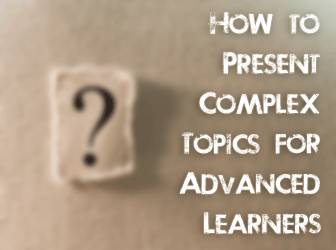Beyond Opinions: 3 Ways to Facilitate Stimulating Discussion


There is no better time in a student’s career to expose them to complex topics that can be utilized in a number of different ways. Follow these tips to get students thinking about the bigger issues in life and a larger world.
The biggest issue with approaching meaty topics in an ESL class is choosing what topics will offer your class the most mileage and learning possibilities. You have a lot of options, and a lot of your choices will be based on what will motivate your students. Think about what kinds of things will prompt them to get really passionate and involved. Here are some considerations to make with some of the various topical choices.
Social issues can be defined as problems or matters, which affect a group of people or the whole society in general, either directly or indirectly. Social issues also have a very wide scope. There are many different types of social issues, some of them very broad-based and others very specific. Social issues should pertain intimately to your class. So if you are overseas, you’ll want to consider what localized social issues you can think of to bring into play that students will have knowledge and opinions about.
A good starting point may be to have a discussion with your students about social issues. Then you could do a brainstorming activity in which they come up with social issues that are relevant to them, and then categorize them.
Here are some examples:
- Homelessness, immigration, poverty: human rights
- Global warming, pollution, recycling: environmental
- Unemployment: economic
- Cancer cures: health
- Information age: technology
- Elections, scandals, terrorism, war: politics
This list will be long and you can ask students to add as much detail as you would like. Just having this discussion with them about the issues that are central to their lives, is a discussion about considerable issues. Ask the students to choose five topics from their long list that they, as a group, would like to discuss, learn more about and base projects upon.
From there you can devise some activities based upon the issues your students have chosen. Some of what you can do will be determined by the topics they chose. If they chose many controversial issues that could easily be argued, you can set up debates or projects in which they research a particular viewpoint of an issue. Debates are a wonderful way to get students talking, but they do take a significant amount of prep work and lead up time if they are really going to be successful. If the students chose a political topic an elaborate way to incorporate that into the class, is to have an election situation or debate between candidates. This also takes some prep work ahead of time, and students will each need to have a very specific role. Divide the class into small groups and then assign the groups a political party—could be Democrats, Independents, Republicans, or whatever is relevant to their country. Have each group decide what their three main topics are going to be (jobs, healthcare, immigration, etc.) that they will discuss and target. You can then either have a debate or election where each party has to take questions from a mediator and/or the public. This is a great lesson if it happens to be an election year. You can adapt it to be as involved or as simplistic as you want. Students will need time to research and put together their talking points.
If they chose issues that aren’t so heated, but that are better-suited to discussion, you can formulate discussion topics or questions. Then formulate different ways to divide the class up and have days where you have three to four stations set up. At each station a different discussion is taking place, and students can join in and move around as they choose. This is a more light-hearted activity that could be done for parts of a class and then students come back together as a group and debrief about what they gained from the discussions.
One last strategy for bringing complex topics to light is to bring in a reading. It could be an article, a story, or even a book of your choosing. If students have shown interest in certain types of readings before, include readings which have strong morals, interesting outcomes, and plenty of space for analyzing and dissecting. Students might be a little leery at first, so you may want to start small, especially if you are going to focus on a work of fiction. There are guided readers that are available for ESL learners that you can tap into, and often those have built in discussion questions and activities. You can always come up with your own ways of how you want to generate discussion of larger topics with readings. You can have students answer questions at home and then do small group discussion. You could also have students pick an excerpt that they particularly like or that resonated with them and use that as your discussion starting point. One other thing you might like to try is to have students do predictions at a certain point in the story, or even write their own alternate endings. When readings have an underlying social issue like the book The Help, your possibilities for discussion and dissection of text, meanings, and language is unlimited.
Students will respond best when the subject matter hits home for them. By bringing in these topics, and allowing your students to voice opinions, argue, and challenge one another you are facilitating in a very constructive and meaningful way.